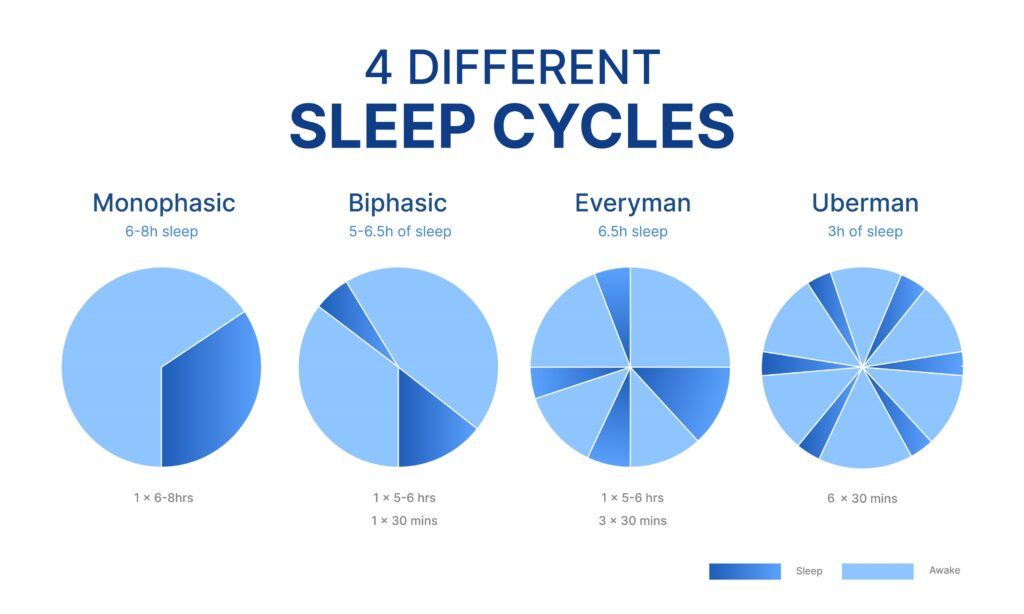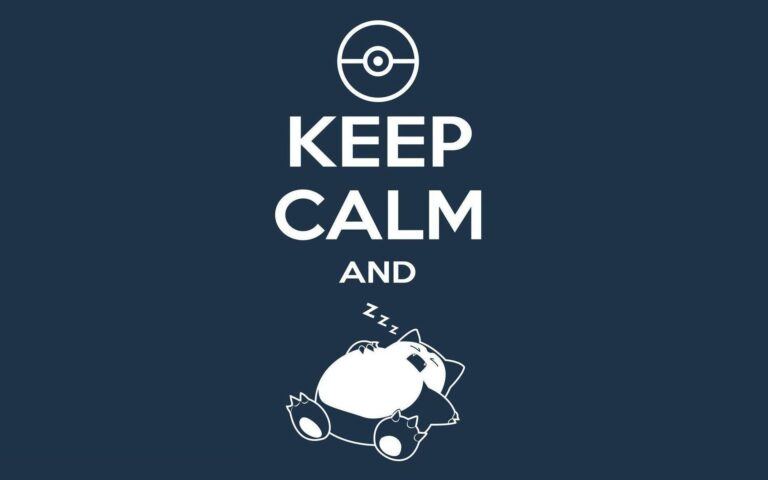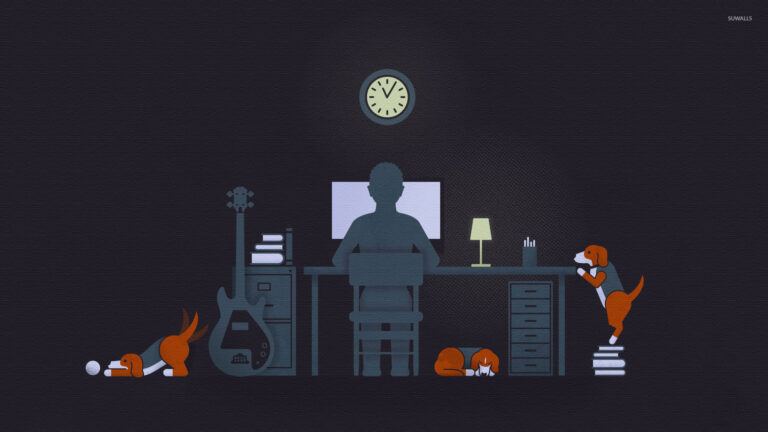What Are The Different Types of Sleep Patterns?
Human beings have something called a circadian rhythm that is internal. It is a behavioral and biological process that occurs every single day, basically a 24 hours cycle. Despite having something like this, what do you think is a correct time for a person to sleep at night?
We all can’t deny the fact that sleep plays a vital role in human health. Have you ever thought of the healthiest option that you could go for when it comes to sleep?
Types of sleep pattern
This article will give you clarity about the different types of sleep patterns and how they affect your sleep hygiene and health.
The most common types of sleep patterns are explained below:
- Monophasic sleep pattern
Monophasic sleep in today’s world can be referred to as the normal way of sleeping. These sleep patterns became the day-to-day norm as it comprises the normal working hours time. Some of the Scholars argue that the modern physics sleep pattern has been adopted by the people only after the industrial revolution.
This particular sleep pattern has developed only since the advent of electricity and due to the exposure of bodies to light, the melatonin levels have started decreasing. This can refer to a person who was exposed to sunlight. It is also said that there are chances that monophasic sleep could affect a person’s sleep-wake cycle and can have a negative impact.
- Biphasic sleep pattern
People who follow biphasic sleep patterns are known to have slept for longer hours at night. People who have biphasic sleep patterns sleep for more than 6 hours at night. It is considered to be healthy and normal. This type of sleep pattern increases the energy of a person and increases productivity. Biphasic sleep pattern is considered to be healthy when compared to monophasic sleep pattern.
Interestingly, many countries recommend their citizens to follow biphasic sleep patterns as routine ones.
There is another form of biphasic sleep pattern which is also called segmented sleep refers to most of the natural form of sleeping patterns. Segmented sleep is nothing but includes two sleeping periods one which occurs during the day and another which occurs during the night.
Segmented sleep can also be referred to as the daytime power nap that we take. Power naps are considered to be more beneficial when it comes to sleep health. A power nap can enhance creativity and alertness.
- Polyphasic sleep pattern
Polyphasic sleepers usually sleep 3 to 6 times during the morning. Sleep pattern is usually broken down into several categories that include Everyman, Uberman, and Dymaxion.
- Everyman: Everyman is considered to have a long sleep duration of 3 hours that is broken down into 20-minute sleep throughout the entire day.
- Uberman: In Uberman a person sleeps only for 3 hours that can be broken down into 30 minutes naps throughout the day.
- Dymaxion: Dymaxion a person sleeps for only two hours a day. This particular sleep pattern can be executed in a 30 minutes nap that happens in a 6 hours interval.

People’s sleep requirements deserve from people. Some of them might require 9 to 10 hours of sleep for effective function. Whereas others might have a healthy and productive life within 5 to 6 hours of sleep per night including power naps during the day.
Difference between Polyphasic and Biphasic sleep patterns
Biphasic sleep can also be called a bimodal or bifurcated sleep pattern. Biphasic sleep is considered to be the practice of sleeping two times a day. This is the common sleep pattern followed by most people.
On the other hand, polyphasic sleep is also called as segmented or divided sleep sometimes referred to as interrupted sleep experienced by numerous shorter periods of wakefulness.
A common feature of both polyphasic and biphasic sleep patterns is napping. As we all know napping is a short duration sleep that is taken between 9 AM and 9 PM.
Polyphasic sleep was first in the early 20th century. This does not apply to a particular sleep pattern or schedule and it depends on the person who sleeps. As mentioned before polyphasic sleep can take place in three different stages which are Everyman, Uberman, and Dymaxion.
Facts on polyphasic and biphasic sleep pattern
- Internal circadian rhythm is considered to be responsible for a persons’ sleep-wake cycle.
- Biphasic sleep pattern is also called a siesta sleep pattern as a person sleeps twice a day.
- When a person sleeps at frequent intervals during the daytime, then it is considered to be a polyphasic sleep pattern.
Are polyphasic and biphasic sleeping patterns harmful or beneficial?
Most people follow a monophasic sleep pattern which means they have a sleep pattern that consists of 7 to 8 hours of sleep. This kind of pattern has become routine in modern society and finds it exactly fits the work schedule of most people. However, we need to understand the fact that not everyone has the same sleep pattern. Some people have both monophasic and biphasic sleep patterns. Where on the other hand, there are people who follow polyphasic or biphasic sleep patterns.
When it comes to polyphasic sleep patterns the most common ones are the Everyman, Uberman, and Dymaxion. Dymaxion is a sleeping pattern that is very difficult to follow and it’s less common. A polyphasic sleep pattern is not good for one’s health as it can induce visibility or sleep disorders. It can also lead a person to experience sleep-wake syndrome due to its sleep regularity patterns.
Polyphasic sleep patterns can be harmful and are not recommended for a person with health problems like diabetes and blood pressure. Some people regularly follow polyphasic sleep patterns as a routine, but there are a set of people who follow this type of sleeping pattern because they suffer from sleeping disorders.
These types of sleeping patterns lead us to a key question in which we want to know what type of sleep pattern is beneficial for a healthy lifestyle.
People have different opinions, but it is wise to choose the best suits our physical and mental health. Some of the research shows that polyphasic sleep patterns are considered being more effective as it includes several short naps, which are considered to be more beneficial to the brain. On the other hand, a biphasic sleep pattern ensures stability to a person’s mental health and aids more efficiency.
There are varying results and it can be quite hard to answer the question as to whether biphasic or polyphasic sleep patterns are beneficial or harmful for most people. However, it is important for us to be aware of our body rhythm, so that it will be helpful for us to figure out the type of sleep pattern which best suits our lifestyle.
You can also experiment with different types of sleeping patterns and find out the pattern that best suits your health.
Hope this article gave you clarity on biphasic and polyphasic sleep patterns. The world of sleep is considered to be fascinating and all curious to know more about sleep patterns based on the evidence. Always keep in mind to be aware of your body rhythms so that it is easy for you to make the right choice of sleeping pattern.







